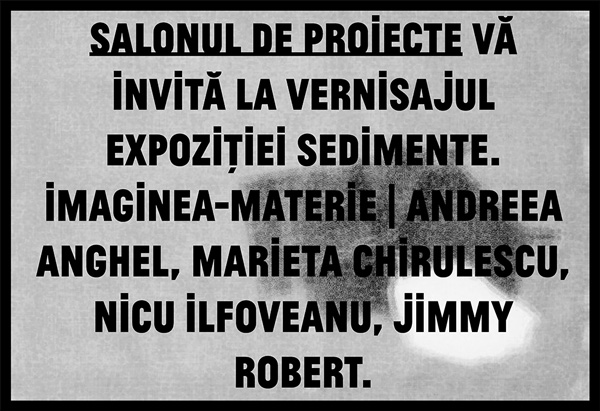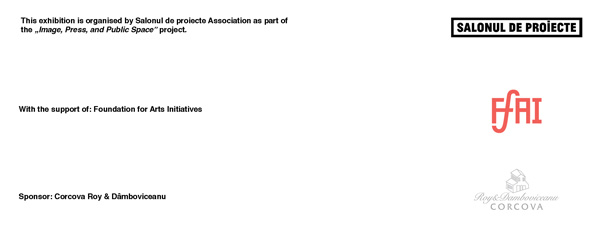SEDIMENTS. THE MATTER-IMAGE
21.06. - 30.07.2023
Artists: Andreea Anghel, Marieta Chirulescu, Nicu Ilfoveanu, Jimmy Robert
Opening: Wednesday, June 21, 19.00
Salonul de proiecte
Palatul Universul, Building B, 1st floor
Actor Ion Brezoianu 23-25, Bucharest
This exhibition can be regarded as the culmination of a number of recent endeavors undertaken by Salonul de proiecte, which are concerned, on the one hand, with an investigation into photographic image, as was the case with the research centered around the Mihai Oroveanu Image Collection, and on the other, with a foray into the history of print, motivated by the Salonul de proiecte’s very location, the former Universul printing house building. These explorations – which concentrated on contextual elements, historical narratives, and the production of new discourses in relation to them – are joined by the current undertaking, which aims to focus on a number of structural conditions of image production through artistic practices that are very different from one another but share the same questioning of the mechanisms of visual representation and the probing of the materiality of the various devices through which images are produced and circulated, given that human existence is increasingly detached from the valences of the physical world, being subjected to an oppressive and unrelenting regime of visuality.
The refusal to create, to invent new representations is a prevalent theme among the perspectives expressed within the exhibition. All the artists work with pre-existing images that they more or less randomly came across while perusing newspapers, magazines, books, and personal archives, images they later subjected to processes of destructuring, obliterating or re-signifying, interfering in a variety of ways on their primary level of concretization, which is frequently difficult to distinguish. The initial instantiation of the image undergoes a sedimentation operation, obtained through successive experimental interventions, to the same extent that a gradual emptying of the “content” is produced. This eliminates the possibility of tying the representation to any referent that would place it in a scenario of recognizable identities. Marieta Chirulescu resists attempts to assimilate her artistic practice to a certain aesthetic context by constructing her works using a variety of intricate reproduction methods. She occasionally starts from archival photographs that she subjects to a process of abstraction, in which the traces of analog and digital technologies that leave their mark on the visual field acquire a central role, without this becoming explicit. The dust deposited on the photographic paper, the stains on the scanner glass and the frame and uneven edges of certain source photographs serve as the agents of cryptic visual creations that also include the pictorial gesture, introduced as both a reproduction and unmediated presence. The surfaces of her work, covered both in human and non-human, voluntary and involuntary interventions, highlight the very impossibility to distinguish between these different registers, maintaining a remarkable auratic quality. Nicu Ilfoveanu, a prolific photographer, interested, among other things, in vernacular aesthetic forms, in the realism of places and existences from various peripheries, in this case distances himself from the classical exploration of the subject in photography and investigates the matter of the image, or rather its rematerialization, by employing some combined multiplication procedures. Through a series of experiments in coloring and handling of the printing sheets, the reproductions of art works from the Secolul 20 magazine [The 20th Century] and the art history visual compendium Propyläen are photographed on film and then offset printed on self-copying paper, creating hybridization effects that overlap the raster dot with the film grain. The initial picture, which was already desaturated in print and affected by the passage of time, takes on a spectral-monumental quality on account of the “obscure vegetation” formed by the interaction between the aggregated materials of paper, ink and printing plates, merging distinct temporalities. For Jimmy Robert, representation is never a given convention or a finished process, as he is also concerned with the structural, material and cultural factors that construct visuality. Poetically, and occasionally critically, yet always in an indirect-oblique manner, his works are concerned with the formation of perception and memory. A newspaper image depicting a murdered prison inmate, about whom the artist has no further information, is partially covered by the contour of a white sheet of paper obscuring the character’s eyes, thus essentially hiding his identity, opening up the possibility to absorb countless speculations and projections, prejudices and assumptions. At the same time, in the video entitled Paramètres, Robert again uses the format and medium of paper to invoke the technical drawing, displaced here to make room for the element missing from this technical language of rational planning: the human body and its existence circumscribed by an accumulation of factors, here and now. Andreea Anghel is an artist from the younger generation who recontextualizes pre-existing images in her practice, using them to construct assemblages that include fragments of found objects that have also undergone various permutations and transformations, managing to create altars of modern anxiety through this enigmatic choreography. Her Saint Incel of 4chan is based on a reproduction taken from a 19th century book, enlarged and inverted, on the surface of which a blond ponytail entangled in a metal mesh is mounted. The artist’s intention is to create a satirical commentary on “incel” masculinity, associating religious iconography with the violent and repressive substratum of subjectivities generated by the digital world.
Special thanks: Galeria Plan B, Suprainfinit Gallery, Vlad Nancă, Galeria Posibilă, Galeria Artep, Colofon, Fabrik, Tanya Leighton Gallery, Roberta Cotterli
This event is organised by the Salonul de proiecte Association as a part of the Image, press, and public space project.
With the support of: Foundation for Arts Initiatives
Sponsor: Corcova Roy & Dâmboviceanu





